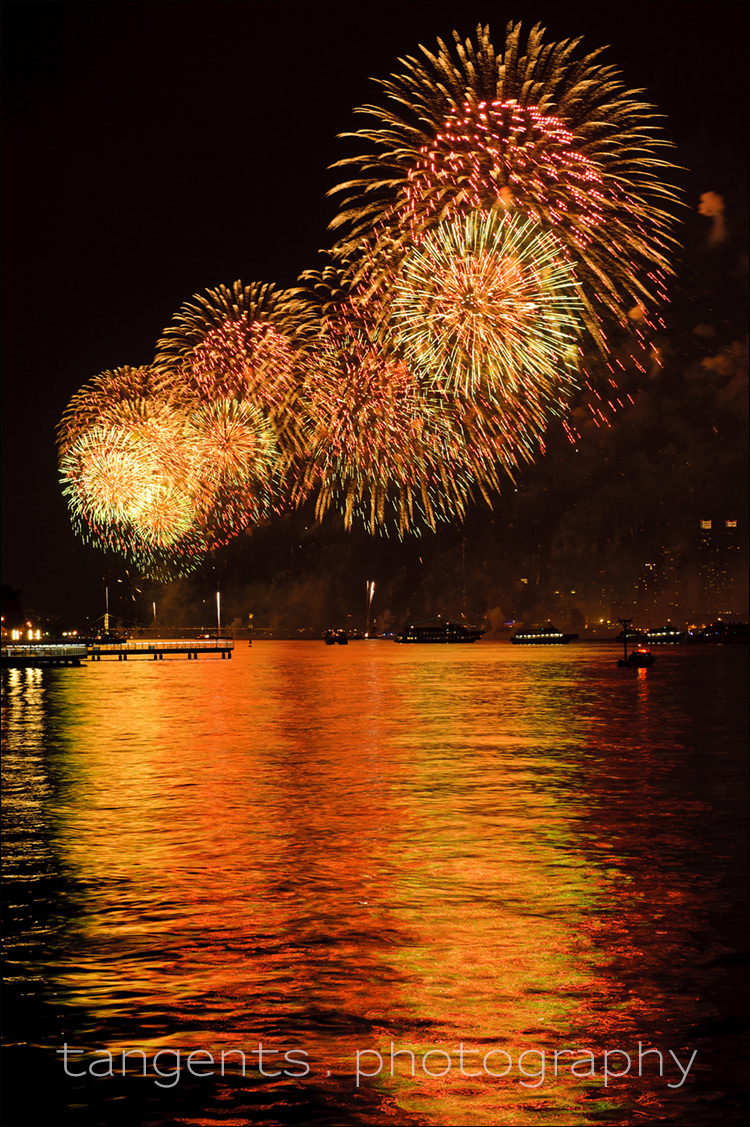
How to photograph fireworks
Braving the crowds (and insane traffic) in Hoboken, I had a good view of magnificent 4th of July fireworks display on the Hudson River, overlooking New York. From this viewpoint, Manhattan is to my right, and barely visible on the edge of the frame. I wanted to include the reflections in the water as well, since the surreal blend of colors helped anchor the intricate fireworks.
The photography technique is simplicity itself – a slow shutter speed, a low ISO and a medium aperture. In terms of photo gear – a tripod and remote release for the camera. Your lens should be wide-ish. A zoom is a terrific idea, because you might not be able to move around and change your composition. All the images here were shot with a Nikon 24-70mm f/2.8 at f/5.6 … which means you don’t even need a particularly fast lens for fireworks photography.
You do need that tripod to stabilize the camera since your shutter speeds will be slow. You don’t want fast shutter speeds, because then you won’t get the full effect of the fireworks burst. In order not to shake the camera, the camera should be fired with a remote release (or a cable release) so that the camera doesn’t move even slightly during the exposure. If you don’t have a cable release, set your camera’s self-timer to a really short duration – 2 seconds. But you might still mis-anticipate the burst of fireworks.
The technique extends further than this though. While I like these images, for they capture some of the magnificence of the display, what is lacking is the context – Manhattan. The classic shots of the 4th of July fireworks display, usually shows some New York landmark in the image, such as one of the easily recognized bridges. Or, the images show Manhattan’s colored lights in the background. For this, I was in completely the wrong place – Hoboken. Far too low down on the Hudson to get the necessary perspective against the Manhattan skyline. Weehawken would most likely have been a better choice here. Well, there is always the next year.
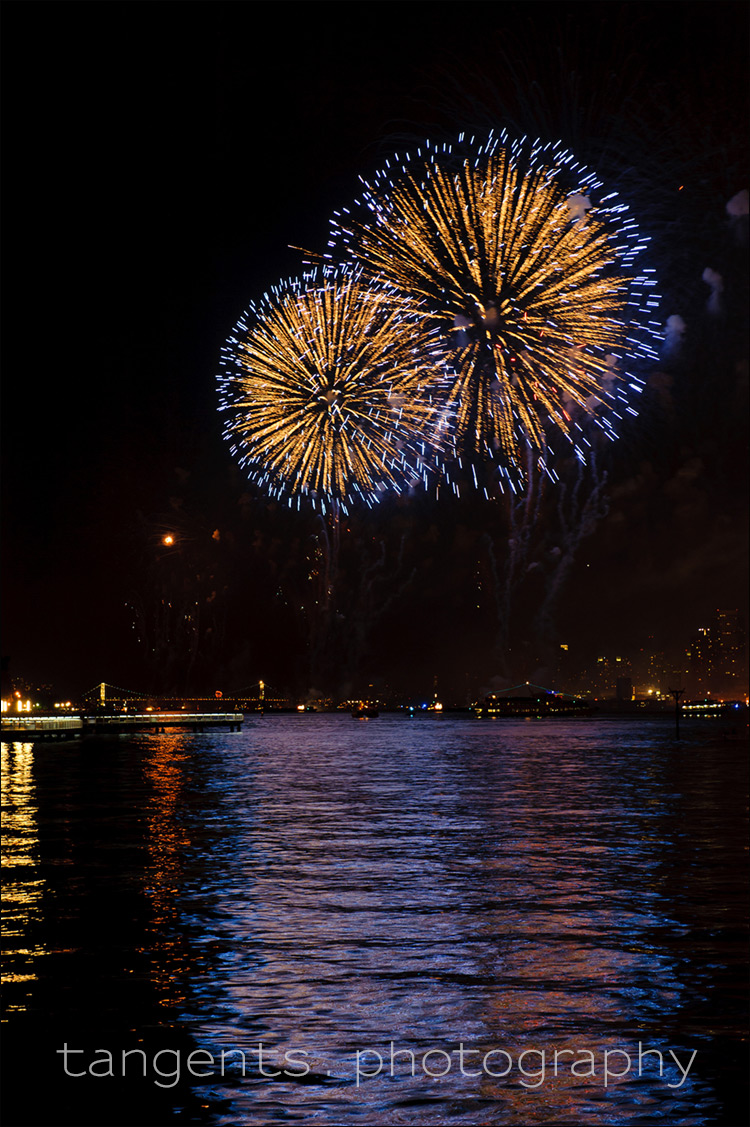
Camera settings for the image above: 1/2 second @ f5.6 @ 200 ISO
However, I felt that for this image and several others, the streaks of light became too much. Too ‘messy’ and with less visual impact. So for the rest of the night, I changed my camera settings to:
1/4 second @ f5.6 @ 400 ISO
White Balance for all images: Daylight. Not all images worked since the brightness of the fireworks display varied a lot! But this is where shooting a large number of images, and then picking the best afterwards, really is the best method to ensure some successful images.
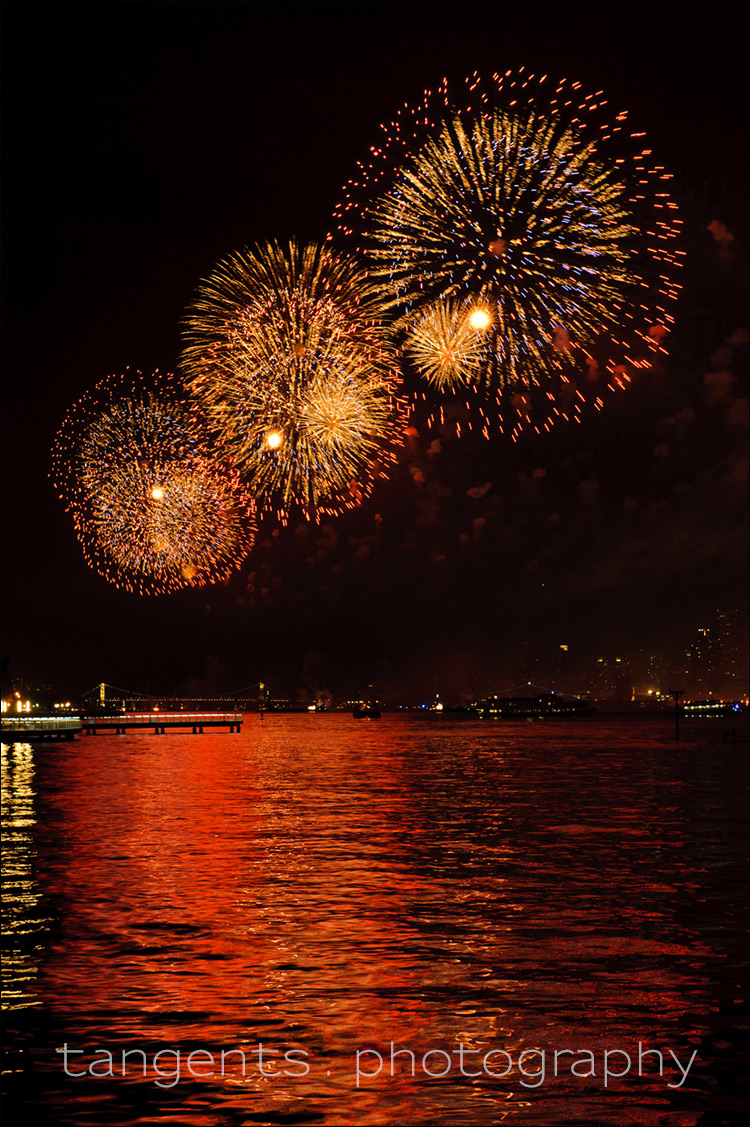
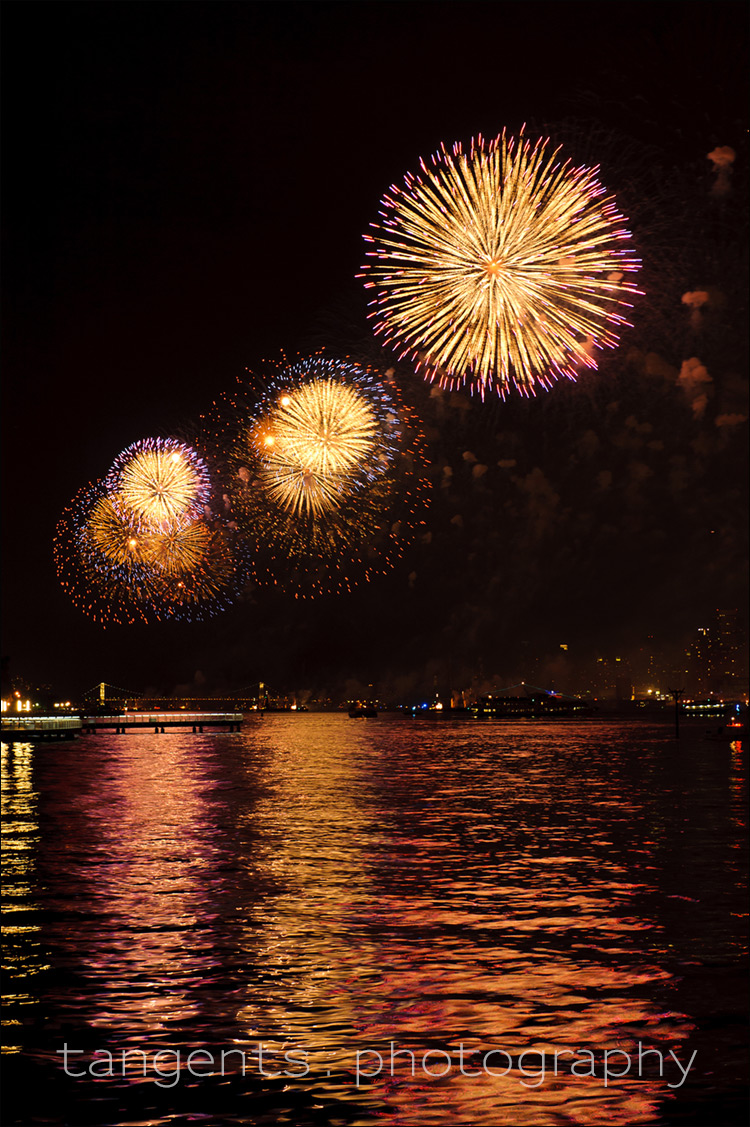
I was fascinated afterwards when the display had ended, by the pall of fireworks smoke shifting over Manhattan.
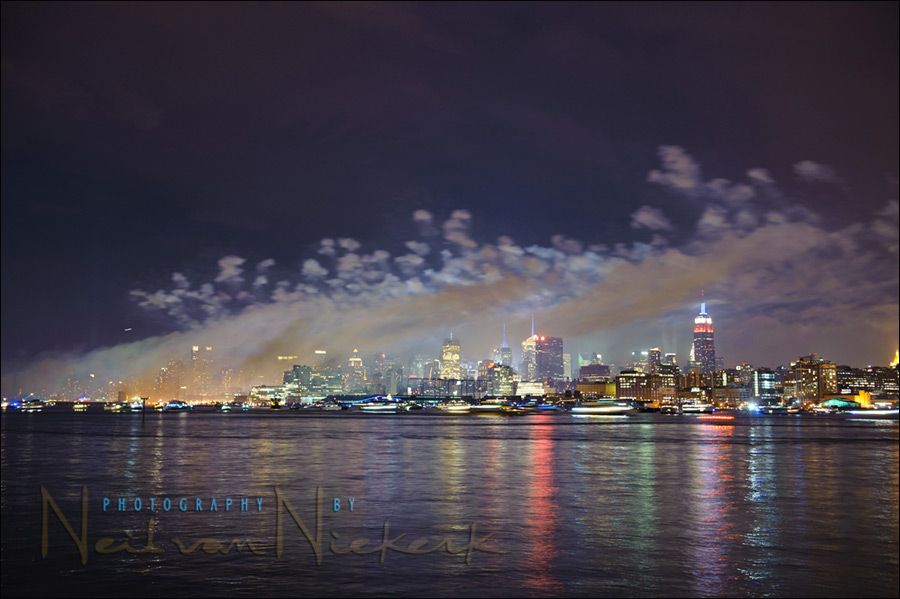
camera settings: 2 seconds @ f4 @ 400 ISO; Incandescent WB
Related articles
Hello Neil,
great article as always very good.
I did not understand why ‘in the last image you left the white balance to daylight.
Why ‘incandescent WB?
It ‘was your choice or you could shoot with daylight WB?
Follow you on your site to me and ‘like a drug!
Every day more ‘times a day do I connect with you to see the fantastic news’.
Good luck and good day
Edy Trigona Genoa Italy
The city lights are incandescent .. or there-abouts. If I had left the WB to Daylight, it would’ve been a murky orange color.
Hi Neil,
you seem to be far from those beautiful fireworks. Did you use your (favourite) 70-200mm f2.8 lens? Or did your change your viewpoint afterwards?
Great pictures! Thanks again for sharing your technique.
Antoine
The last photo is really nice.
I wouldn’t have thought tripods would be allowed in viewing areas, since there would be a crowd. Some areas have security guards that would not allow people to carry much into the viewing area.
Awesome images Neil.
Which camera and lens was use to capture these images?
I wanted. to travel light, and I thought the Nikon 24-70mm f2.8 would be enough. I didn’t realize the fireworks would be so far up the Hudson from Hoboken. So this was the way I had to compose thie shots to fill the frame. The 70-200 would’ve been better suited at this distance. Better yet, the Nikon 24-120mm f4 (or Canon 24-105mm f4) would’ve been the ideal lens here Wide enough, bjut with some reach. I guess I will have to go shopping then. There’s always that to look forward to … shopping for more toys.
The tripod I took with me was one of Manfrotto’s carbon fiber tripods .. light-weight and relatively compact. No issues from the cops this time.
The camera I used was the Nikon D3
Hi Neil,
Great, as usual. What were you focusing on? The water looks pretty sharp so I can’t tell what your focus point was.
Thanks,
Jerry
I focused on the fireworks, and then locked my focus by going to manual focus. Since it is at infinity, and shot at f5.6 much of everything that is static in the frame, will be sharp.
I envy folks who have great locations available to them for shooting fireworks. I had planned to do such in my small Ohio community last night, but location selection wasn’t particularly rewarding. Wound up with nothing I wanted to keep.
I have been wondering how this is done. Thanks so much for this blog post!
Not sure why, but the fireworks in these shots look blurry to me– as if you didn’t use a tripod. Although, it’s clear that you did, since the landscape content at the bottom of the shots is all solid.
Half second exposures + wind + moving trails = blur.
What about using a monopod? Will look forward to your review of the 24-120mm F/4 VR :)
Monopods are too wobbly for such slow shutter speeds.
And yup, I pulled the trigger on the Nikon 24-120mm f4 today. It should be here later this week. I fully hope it is as good a lens as the Canon 24-105mm f4
I shot some fireworks with my D7000 this past weekend, as well as a few weeks ago at our local Riverfest here in Wichita. I found that to get a similar look to yours, I had to shoot at least 2 seconds on the shutter. A half or quarter of a second wasn’t nearly long enough to capture the whole burst. Here’s what I ended up with:
Riverfest 2011
Independence Weekend
I tried the to capture the fireworks at Chicago navy pier from the North Beach, and due to the fact that the fireworks were small and limited this year , the spot I picked was not good enough. The idea was to capture both the skyline and and fireworks, but it turned out the fireworks were too small in comparison to the skyline. Next time I will be on the other side so the works are closer to the camera. In my opinion if you don’t have nice background or something nice to go with the works your image will be forgotten quickly.
Bart, you, I also think photographs of fireworks look best if there is some context. Something to anchor the spectacle to a place.
Neil, did you consider the new Nikon 28-300 when buying the 24-120? It’s unreasonable to expect top-notch image quality from such an all-purpose lens, but it still intrigues me.
hi Neil, you managed to get the fireworks shot with very very little smokes around it, Is it composition thing or there’s any other way to avoid the smokes, which ruined most of my shot which i took last year.
Thanks
urgyen
Michele, as I said, there’s always a next year, so if you’re in New York again, drop me a note.
I usually use the bulb setting and open the shutter as long as I want, covering the lens while the shutter is open if necessary. This year I will try using the Live Composite feature on my Olympus, which keeps the base exposure and only records changes in light. It’s great for star trails, but haven’t used it with fireworks yet. (Though if anyone can figure out how to use the self timer or a remote with Live Composite, I’m all ears.
The fireworks on the Hudson up in Yonkers is much more manageable than NYC’s (but not nearly as big), and it’s super easy to get to by Metro-North.
Can anyone give me tips for this scenario? I will be on a canoe in the middle of the East River. A tripod is not going to be an option. I assume that I won’t need my zoom lens, based on this post. My wider lens is AF-S Nikkor 25-55mm DX (Using Nikon 3200). My zoom is Tamron that ranges from 70-300. The zoom is hard to keep focused without a tripod unless the shutter is very fast.
Robin … I don’t think there’s an easy option for you in a canoe. There will be movement. You might be better off hand-holding the camera with a lens that has stabilization. Keep your shutter speeds relatively fast then. Shoot a lot.
Great shots Neil. I have a wedding coming up and they have planned a firework display so this is useful to me, thank you. Assuming I wanted to have the bride & groom between me and the display with their backs to me I’m guessing I just need to tell them to keep still or would you use a flash with 2nd curtain sync?
Barry
The difference between rear curtain sync and first curtain sync, only kicks in if your subject is moving in the frame .. which isn’t happening here since your couple will be static in the frame. So there will be no real difference between the two modes here.